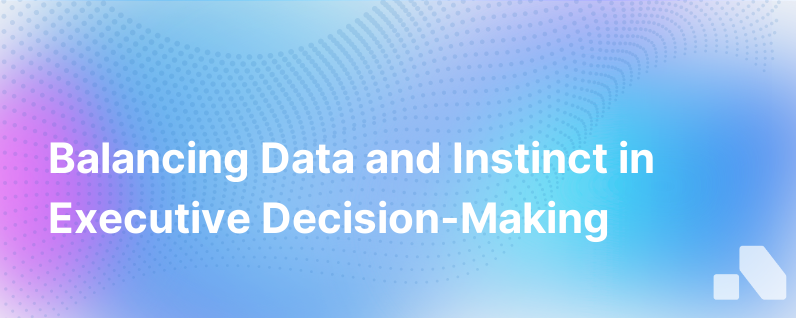Data And Instinct
Published on September 12, 2023 by David Zhang
In today’s data-driven business landscape, the pendulum seems to have swung decidedly toward numbers and analytics as the foundational pillars of decision-making. However, the interplay between data and instinct is far more symbiotic than it may appear on the surface. Embracing this duality is vital for leaders who must navigate increasingly complex environments.
Understanding the dynamics between data and instinct can be transformative in generating insight, enhancing strategy, and driving innovation. Balancing these elements can empower firms to not only respond to current needs but also to anticipate and shape future possibilities. To effectively integrate these contrasting yet complementary forces, one must consider their nature, benefits, and the framework for harmonization.
The Nature of Data and Instinct
Data: Data is quantifiable, objective, and often presented in a structured form. It enables concrete analysis of trends, patterns, and correlations. It has been the cornerstone of empirical research and business intelligence, embodying the principle that you can only manage what you can measure. From customer behaviors to financial performance metrics, data is indispensable in painting a clear picture of the present and predicting future outcomes with a high level of accuracy.
Instinct: Instinct, or gut feeling, on the other hand, is an inherently human trait. It stems from our innate ability to synthesize our experiences and emotions into an intuitive comprehension of a situation. It is the product of tacit knowledge – the things we know but cannot articulate in data or words – such as the nuances of team dynamics or the undercurrents of customer satisfaction.
The Benefits of Both
Strengths of Data:
- Precision and Clarity: Data provides precise information, which is essential for analyzing specific metrics and KPIs.
- Scalability and Repeatability: Once developed, data models can be scaled and replicated across different parts of the business.
- Risk Mitigation: Data supports evidence-based decisions, reducing the element of risk associated with uncertainty.
Strengths of Instinct:
- Speed: Instinctual making decisions often occur much faster than data-driven ones, which can be critical in time-sensitive situations.
- Innovation: Gut feeling can foster innovative ideas that data may not readily suggest, as data tends to be backward-looking, reflecting only what has already happened.
- Cultural Sensitivity: Instinct plays a role in understanding and navigating complex human interactions, which are often impervious to quantification.
Bridging the Gap
The Framework for Harmonization:
-
Start with Data: Ground your strategy with data to understand the context and parameters of the environment in which you operate. Let the data inform you of the trends and patterns that require attention.
-
Infuse Instinct: With a solid base of data, allow your instinct to play a role in interpreting and predicting scenarios where data may be incomplete or not forward-looking enough. Instinct can fill the gaps in data, especially dealing with unprecedented circumstances.
-
Test and Validate: When your instinct leads you to a specific course of action, test that hypothesis and validate it with data. This could involve running a pilot program, A/B testing, or using predictive analytics.
-
Establish Feedback Loops: Whether data or instinct drives a decision, it’s critical to create mechanisms for feedback. Positive feedback can reinforce a decision, while negative feedback can provide the data needed to pivot and adapt.
-
Embrace Adaptive Learning: Use both successes and failures to inform both your data models and instinctual decision-making. Over time, this will hone your intuition and improve the accuracy and effectiveness of your data analytics.
-
Create a Culture that Values Both: Encourage your team not only to respect data but also to trust their instincts. Create an environment where questions are encouraged, and insights are valued, regardless of whether they come from a spreadsheet or a hunch.
Overcoming the Challenges
Balancing data and instinct can be challenging. One significant hurdle is cognitive biases – instinct may be plagued by them, while data can be misinterpreted or misused due to the same biases. The human side of decision-making can be clouded by emotions, under- or over-confidence, and past experiences that may not be relevant to the current situation.
To mitigate these risks, leaders should:
- Be aware of personal and organizational biases.
- Foster a culture of transparency and honesty about the decision-making process.
- Encourage diverse perspectives, which can offset individual biases and provide a more holistic view.
Conclusion
In the modern business landscape, those who can adeptly fuse data and instinct are often the most successful. While data provides the map, instinct lights the path often not yet charted. In a world where predictability is a thing of the past, and where markets, technology, and consumer preferences shift in unprecedented ways, relying solely on data or instinct can be myopic. The most powerful insights come from a harmonious blend of both, combined with the wisdom to know when to lean more heavily on one or the other.
In conclusion, whether you're analyzing customer data to optimize sales strategies or relying on your gut to make a critical business move, remember that neither data nor instinct should be an island unto itself. Instead, they should function as continents in the same world, connected by bridges built with wisdom, experience, and the courage to navigate the unknown. For businesses seeking a better balance between data and instinct, employing tools like Aomni can help them to master this balance effectively.